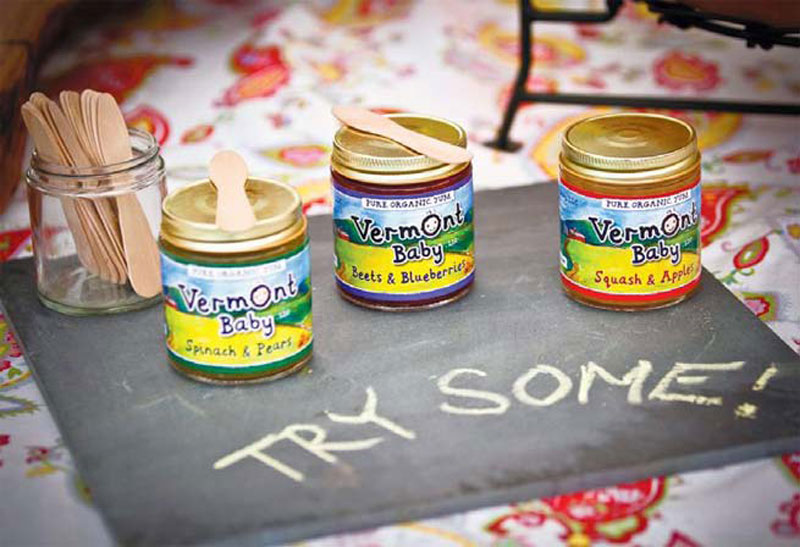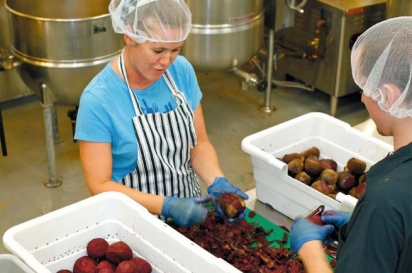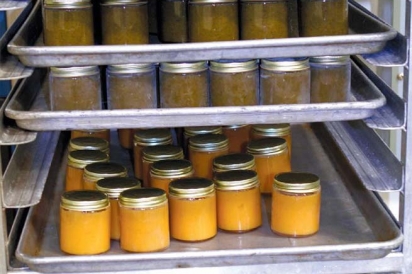Baby Steps: All-Natural Baby Food by Vermont Baby
Sooner or later, most foodies wonder what it would be like to market their own line of food. After years of receiving compliments about Aunt Edna’s fudge sauce or their own secret recipe for a truly delectable salsa, they ponder the possibility of turning their passion into a profession and starting up a food company. After all, there are plenty of examples on the supermarket shelf of what can happen when you mix a clever entrepreneur and a good product. (Think Ben & Jerry’s or Nantucket Nectars). What was once a kitchen project given out to friends becomes a global brand, with the dollars and the glory to go with it.
However, the actual process of getting a packaged food item to market is so complicated that it deters all but the most dedicated and stubborn. Allyson Spanier is one such determined woman. She decided to fill what she considered a void in the market: all-natural baby food that actually tastes good. The road there has been bumpy and frustrating but she just may be on the precipice of a successful launch.
Spanier lives in Cambridge, Vermont, with her husband, J.J., daughter Addie, and son Bodhi,. She holds a master’s degree in education and taught elementary education for several years but when Bodhi came along she took time off to be with her children. As Bodhi approached age 2, she considered going back to work but had second thoughts about the direction her life might go. Rather than return to teaching she was inspired by her husband, who is self-employed. The freedom of being her own boss appealed to Spanier and she considered how she might earn an income while doing something on her own time schedule.
She had had an idea brewing in her head since her daughter was born but had yet to voice it as a possibility until her husband asked, “So what do you want to do?” Her answer: baby food.
When Addie was born, Spanier made almost all of her food at home using fresh ingredients. She had a few combinations that worked particularly well: pears and spinach, apples and winter squash, peaches and sweet potatoes, and beets and blueberries. She not only made the purées to nourish her daughter but tasted them often to make sure they pleased her own palate, ensuring that what she was feeding Addie actually tasted good.
As happens with all mothers, however, she didn’t always have the time to make homemade food and so she looked to the grocery store for other options. The big national brands didn’t appeal to her; the taste was subpar, the consistency unappealing and they were quite watered down. There were a few alternative, all-natural brands but Spanier found when she tried them they didn’t taste anything like the ingredients listed on the label.
When Bodhi was born, and she had even greater need for convenience, the idea of producing the baby food herself began to take shape. The concept of taste had been overlooked in the category of baby food. In fact, for most adults, the thought of eating the mealy, sometimes malodorous jarred purées is a little repulsive. Baby food companies emphasize nutrition, which is important, but we have come to accept the idea that it is OK to feed a baby food that we, ourselves, would not deign to consume.
Spanier felt that good taste was important for a developing palate and by making the purées with fresh, organic ingredients and minimal processing one could craft food that is both nutritional and good tasting. In the midst of a strong locavore movement and living in the middle of farm country, Spanier realized that she was well positioned to produce and market the food herself. She would call it, quite simply, Vermont Baby.
The first step was to figure out her first step. Luckily, she found a course offered by Sterling College in Craftsbury, Vermont, that was geared for exactly her kind of venture. It covered everything from packaging, FDA regulations and distribution to labeling and marketing. After taking the course she launched herself into market research both on the web and in the grocery aisles. She felt confident that her product could compete with the brands she found on the shelves if she could recreate the high-quality purée she made in her kitchen.
Her product, however, falls under the category of acidified foods (others would include salsas, pickles and some condiments). She would have to meet requirements of pH and temperature during the canning process to maintain food safety. Holding on to the flavor of the purées as she had intended them with all of these variables would be a challenge.
Spanier also needed an FDA-approved kitchen to produce her line. Luckily there is a facility in Hardwick called the Food Venture Center, where aspiring culinary entrepreneurs can rent kitchen space to make their products on a large scale in commercial-grade conditions. The Food Venture Center also helps with technical services, business plans, financing, distribution, access to food scientists and cooking assistants. For a first-timer, having this type of guidance is invaluable and it is safe to say she would not have endeavored without it. With help in the processing aspect lined up, she plowed ahead with the rest of her to-do list.
One of the most important (and fun) steps was to cement a brand image. In coming up with a label, she tried an online service called 99designs.com in which designers submit their ideas for a label for free. There were many responses but none of them quite captured what she was looking for. As luck would have it, she had been invited to a local baby shower and noticed that the invitation depicted exactly the style of illustration she had in mind. The designer, of course, was a Vermonter and Spanier hired her to design the label, realizing that only a fellow Vermonter would truly capture the spirit she wanted to express on her Vermont Baby labels.
With the jars and labels purchased, time at the Food Venture Center reserved and a spot at the Montpelier Farmers Market booked, there was still a major obstacle to overcome: insurance. Given the litigious nature of the entire baby industry, Spanier could not find an insurance company that would cover her for a reasonable rate.
Months rolled by as she made phone call after phone call to no avail. With everything else lined up and ready to go, she became frustrated and depressed that the insurance issue was going to sink her entire plan. So with gritted teeth, she rearranged her budget and took on an insurance company that was much more expensive than she had planned so she could at last get into the kitchen and start cooking. Finally at her first day at the Food Venture Center, Spanier rolled up her sleeves and prepared to make her first recipe at 30 times the scale of her homemade batch. Instead of cooking for one toddler, she now faced a 40-gallon steam pot and a pile of pears and spinach that made your fingers cramp just looking at them. An assistant was assigned to direct her through the first few days of processing and she was lucky to get a dedicated, professionally trained chef in the person of Conner Gorham. She had her recipes exactly as she liked them but increasing the quantity of a recipe is not always a linear equation. She dived in, however, and the first few tries were an exercise in adjusting proportions and playing with means of sustaining the right pH.
Keeping good flavor was paramount, so she and Gorham experimented with the best way of canning (hot fill or water bath?) that would not alter the fresh flavor she was aiming for while still maintaining food safety. She checked her product after each batch was cooled and had two dispiriting afternoons as entire batches had to be tossed for insufficient pressure inside the jars.
Eventually she and Gorham got their recipes in order with the right pH, the best method of sterilizing and the fresh flavor she originally intended. Spanier said the best compliment she got was when Food Venture Center manager George Keener gave the purées a try and ended up eating the whole jar.
At last she was ready to sell. Spanier began taking her product to the Montpelier Farmers Market and the Jeffersonville Farmers Market in mid-summer. The reaction from the customers was inquisitive and positive, since few items like this are ever introduced. Only a portion of famers market attendees are in the market for baby food, though, so the lines in front of her stand were, at first, a little disappointing to her in comparison to the frenetic energy in front of the farm stands. She has been building a supportive customer base, however, with moms returning to her stand whenever she is there to stock up for their babies. Spanier is encouraging families to buy it for their toddlers, too. She has found that her son Bodhi really enjoys holding the jar in his little hands and spooning the wholesome food himself.
As for the taste, she is pleased with her results and readily off ers samples to customers both young and old. Th e response is enthusiastic and one mom confessed she ate a whole jar out of the fridge during a late-night snack attack. Th e target audience seems to enjoy it too. I witnessed many little ones taste a sample and then reach their chubby little hands out for the rest of the jar in the universal toddler-speak of “More!”
Spanier is also happy with the pace of the growth of her business, especially since she still juggles her time with being a wife and mother of two young children. She hopes to spend this coming year building brand recognition and getting the product into more natural food stores and co-ops in Vermont. She will also attend a few food expositions to get exposure in the greater New England area. Further down the line, she has some ideas for snack foods and frozen purées. Freezing gives her more options for diff erent fl avors since regulations for processing frozen foods are more fl exible than shelf-stable foods. She would like to give some time for Vermont Baby to grow fi rst, however. She says, “I really want to establish Vermont Baby as a well-known brand before shifting to frozen since the frozen food section isn’t the fi rst place people go to fi nd baby food.”
For the moment, however, she is content with being small and building at a rate that she can manage. She has thought about marketing to New York and New Jersey since Vermont-made products are quite popular there. But, she states, “I’m also not opposed to staying in Vermont and keeping my product as a novelty item that they can only get here. I guess we will have to wait and see.” Fellow foodies with their own market dreams will also be waiting to see, and rooting for her all the way.
Vermont Baby products can be found at the Farm Store in Jeffersonville, Vermont; on Facebook or by contacting Allyson at VTBaby.com.









